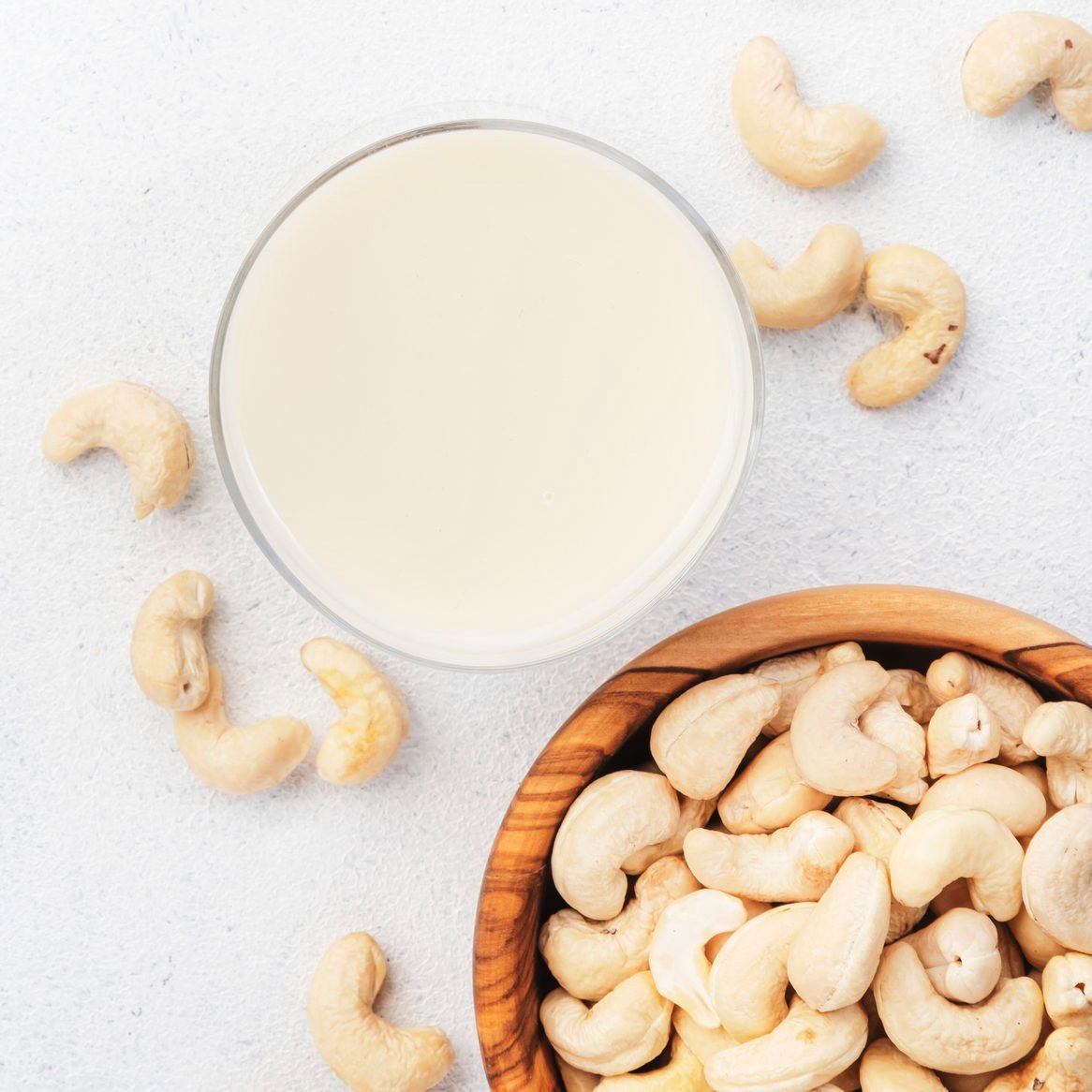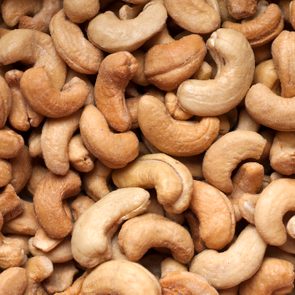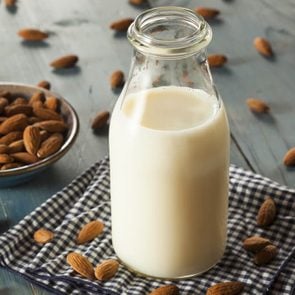10 Easy Ways to Use Cashew Milk
Updated: Mar. 16, 2022
Cashew milk is a dairy-free alternative with a creamy texture and mild flavor. Here are recommendations from registered dietitians on how to use it at home.
Our editors and experts handpick every product we feature. We may earn a commission from your purchases.
Choosing plant-based milk
Done with dairy milk? Maybe it gives you tummy troubles, or maybe you’re looking to reduce your carbon footprint by following a vegan diet or eating more plant-based foods. Whatever the reason, you’re not alone.
The trend of avoiding animal-based foods is growing: According to a 2019 Nielsen report, 15 percent of food and beverage dollars were spent on products that fit a plant-based diet, up 1.7 percent from the year before. This includes plant-based milk, such as cashew, coconut, soy, and almond milk. (Here’s the difference between cashew milk vs. almond milk.)
“For people with dairy sensitivities or allergies, plant milks offer a delicious and healthy alternative,” says Robin Foroutan, a New York-based integrative medicine dietitian and spokesperson for the Academy of Nutrition and Dietetics. That’s good news for the 65 percent who report a lactose intolerance, meaning they have trouble digesting lactose, a sugar found in dairy milk.
Although the choices for plant-based milk can seem overwhelming, many of our registered dietitians love cashew milk for its super creamy texture and mild flavor. “Cashew milk is a plant-based milk alternative for those looking for a nondairy option that’s lactose free, has healthy fats, and is versatile,” says Rahaf Al Bochi, RDN, a registered dietitian nutritionist in Atlanta and a spokesperson for the Academy of Nutrition and Dietetics.
What’s more, it’s easy to make your own cashew milk to retain more of the whole cashew nuts’ nutrients and avoid the sugars and additives in many store-bought varieties.
What is cashew milk?
Technically a seed, cashews form at the end of a fruit called a cashew apple. (Once you see how cashews grow, you’ll never see them the same way again.) Cashew trees, native to South America, are now grown for their nuts in India, Vietnam, and parts of Africa. The milk is made by squishing the nuts and blending the pulp with water; flavorings can also be added.
If you’re buying store-bought cashew milk, read the label carefully. It may contain additives you don’t want, while missing out on nutrients you do want.
“Store-bought nut milks are convenient, but making your own at home allows you to get more of the nutrition that’s in the nuts, since it’s not as watered down,” says Rachael Hartley, RD, a registered dietitian in Columbia, South Carolina.
“The downside of cashew milk is that it is low in protein compared to cow’s milk or other nondairy beverages like soy milk,” says Al Bochi. “And it can be high in added sugars if the cashew milk is sweetened.” Making it at home can help preserve more of the cashews’ natural protein.
One benefit of store-bought cashew milk? It’s fortified to better match certain nutrients in dairy milk.
“Unfortunately, homemade cashew milk does not contain calcium and vitamin D, as [cow’s] milk or store-bought cashew milk does,” Hartley says. If you’re making your own, make sure you get your calcium and vitamin D from another source.

Making your own cashew milk
Cashew milk is one of the easiest nut milks to make because the nuts’ smooth consistency doesn’t require straining.
“For purists, it might be fun to make your own plant milks,” Foroutan says. “It’s not complicated and it tastes really delicious.”
Not straining the milk also allows you to retain more protein and other nutrients that would otherwise be left behind. In addition, “some people prefer homemade nut milk because it doesn’t have any added thickeners or stabilizers, which can cause belly aches for some people with sensitive stomachs,” Foroutan says.
How do you do it? Simple. “To make your own cashew milk, just soak cashews overnight, then blend with water—use four times the amount of water as you do nuts—in a high-power blender,” says New Jersey-based registered dietitian Erin Palinski-Wade, author of 2 Day Diabetes Diet. “Don’t strain if you prefer a thicker milk.”
Another great thing about making your own is you can alter the recipe to fit your preference.
“You can adjust the consistency by using more or less water, adding vanilla extract, or a little bit of all-natural sweetener, like maple syrup or honey,” Foroutan says.
Nutritional makeup of cashews
Cashews, and nuts in general, are part of a healthy diet. Research suggests they’re good for cardiovascular health, may help manage diabetes, and aid in weight loss because their nutrients and fiber keep you feeling full longer. They’re actually one of the healthiest snacks for weight loss.
“Using cashew milk in recipes adds heart-healthy monounsaturated fats, as well as magnesium, copper, and zinc,” Hartley says. The cashew’s nutritional makeup means it’s one of the healthiest nuts you can eat.
When eating whole nuts, you don’t want to overdo it because they do contain fat and calories; Palinski-Wade suggests having a handful (1.5 ounces) of nuts, including cashews, around four times a week. But Foroutan says when it comes to cashew milk, fat and calories aren’t really a concern.
This is the nutritional value per ounce (28.35 g) of cashews or about 18 nuts:
Calories: 157
Fat: 12.4 g (15% DV)
Sodium: 3.4 mg
Fiber: .94 g (3% DV)
Protein: 5.2 g (10% DV)
Carbs: 8.6 g (3% DV)
Sugars: 1.7 g
How to use cashew milk
As Al Bochi notes, the versatility and creaminess of cashew milk make it a wonderful substitute for dairy in pretty much any recipe. Plus, you really would not know these dishes are dairy-free.
“Cashews can be miraculous in vegan cooking and baking,” Foroutan says. “You’ll see them popping up in plant-based or vegan recipes and restaurants because their consistency is so creamy and delicious.”
Here are some ideas our experts suggested.
Smoothies
“While homemade cashew milk is delicious to drink on its own, you can use it to make an extra-creamy smoothie by blending it with frozen fruit,” Hartley says. Strawberries make it pink, while blueberries make it purple—perfect colors for kid-enticing food. You could also add in greens, chia, flax, or hemp seeds, or anything else you prefer. (Try this delicious coffee smoothie for breakfast.)
Pasta sauce
“Use homemade cashew milk to add a bit of creaminess to pasta dishes,” Hartley says. “For example, stir one-half cup into a tomato-based sauce.” Or, you can use it in cream-based pasta sauces, like an Alfredo sauce, Al Bochi suggests.
Curries
There’s a reason cashews are so popular in dishes from India, where cashews are grown; for example, it’s a key ingredient in the popular dish, chicken korma. Cashews add a rich creaminess that can be used along with traditional coconut milk. Or “if you don’t like the taste of coconut, you could also use cashew milk to make a homemade curry sauce,” Hartley says.
As a nondairy creamer
Forget the powdered stuff: Cashew milk is a smooth and creamy alternative in your morning java. “You can use cashew milk in beverages like coffee,” Al Bochi says. It also works well in tea, or as a base for hot chocolate. Try our RD-approved cashew creamer recipe.
Homemade ice cream and pudding
Because of its rich consistency, cashew milk is popular in frozen dairy treats like vegan ice cream. You can also make the milk thicker—aka “cream”—for an even more decadent dessert. “Cashew cream will really trick your taste buds into thinking it’s dairy,” Foroutan says.
For another dessert idea, Julie Lanford, RD, a registered dietitian and wellness director of Cancer Services, Inc., in Winston-Salem, North Carolina, suggests cashew milk in chia pudding: Just mix chia seeds, cashew milk, fruit or cocoa powder, and refrigerate for a pudding-like snack.
Cashew cheese
Cashew cheese may sound strange, but it’s actually a thing. “There are surprisingly delicious cheeses made from cashews,” Foroutan says.
Making your own is easy, too. It’s basically like making cashew milk except with less water, which creates a cheese-like consistency. Some recipes call for nutritional yeast as well. You can also create a yummy macaroni and “cheese” sauce. Cashew cheese is even great in lasagna.
Cashew butter
Cashew “butter” is another great dairy alternative that itself can be turned into cashew milk. “If you don’t want to start with whole nuts, you can buy cashew butter and go from there,” says Lanford. You can also make your own cashew butter (similar to the milk recipe, but add a little coconut oil instead of water) to use in place of dairy butter in cooking; or as a spread on toast or apple slices.
Soups
Just about everyone we talked to raved about how well cashew milk works in these comfort foods. “You can use cashew milk instead of broth to make a creamy, rich soup,” Al Bochi says.
Foroutan agrees. “It works like a dream as a dairy substitute in traditionally cream-based soups,” she says. Try it in butternut squash soup, cream of mushroom soup, clam chowder, or potato leek soup. The possibilities are endless.
Salad dressing or other condiments
You don’t have to deny yourself ranch dressing. Cashew milk “is really lovely in creamy salad dressings,” Foroutan says. “Or, as a sour cream-like substitute” in dips or vegetarian tacos.
On cereal, granola, or oatmeal
Try cashew milk as a breakfast staple: Lanford says one of her main ways to use cashew milk is simply on cereal or granola. “Cashew milk can also be used to make creamy breakfast oatmeal,” adds Al Bochi. In place of water or dairy milk, cashew milk in oatmeal lends a rich texture. Try it in overnight oats, as well.
Next, here are the foods you think are dairy-free but aren’t.
















